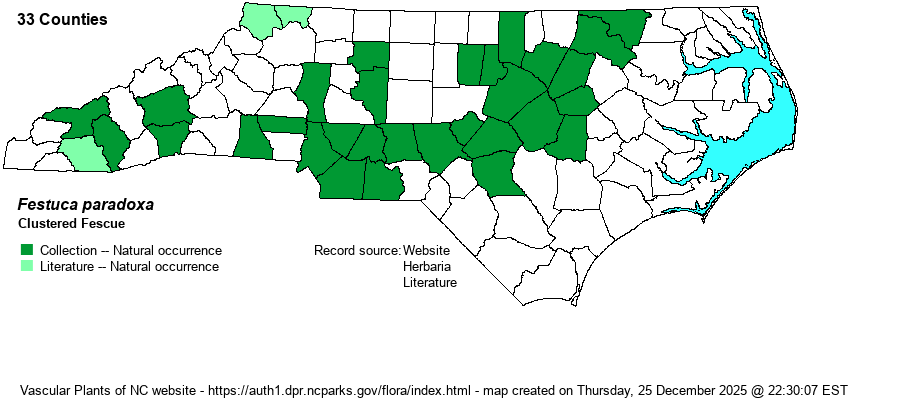| Author | Desvaux | |
| Distribution | Piedmont and southern Mountains; also in Piedmont-like habitats in a few Coastal Plain sites (Cumberland, Johnston, Wayne, and Wilson counties). Absent from the Sandhills proper, and oddly scarce from most of the northern part of the Piedmont and northern Mountains.
PA to WI and IA, south to GA and TX. | |
| Abundance | Frequent in the Piedmont, rare in the Mountains and Coastal Plain. Most numerous in the counties along the Fall Line and in the southern portion of the Piedmont. | |
| Habitat | Mesic to moist soil of hardwood slopes near brownwater rivers, upper floodplains of these habitats; open mafic barrens (Granville County). Prefers circumneutral soils. | |
| Phenology | Flowering and fruiting May-July. | |
| Identification | These plants grow mostly about 2 feet tall (to as many as 3 feet tall). The leaves occupy the lower half of the stem, while the inflorescence occupies the upper third. This species is perennial and thus has 3 easily seen stamens. From F. subverticillata it differs in its much shorter inflorescence branches, each with 8-20 clustered spikelets (vs. long branches with 2-7 spikelets not much overlapping in that species). In its short, blunt glumes and lemmas it resembles many Poa species, but the florets lack any trace of a tuft of wispy hairs. | |
| Taxonomic Comments | None
Bromus, Festuca, and Poa all can look quite similar to beginners (and even veterans!), because they all have multi-flowered spikelets. Generally speaking, Bromus has much the largest spikelets, and most Poa have a tuft of wispy hairs at the base of each floret (lacking in the other genera). Bromus and Festuca have obvious awns on the florets (absent in Poa). With field experience and careful use of keys, one can eventually handle these genera.
Our annual species of Festuca are by some authors placed in the genus Vulpia; they have a single stamen (vs. perennial and with 3 stamens). | |
| Other Common Name(s) | Cluster Fescue | |
| State Rank | S4 | |
| Global Rank | G5 | |
| State Status | | |
| US Status | | |
| USACE-agcp | FAC link |
| USACE-emp | FAC link |

